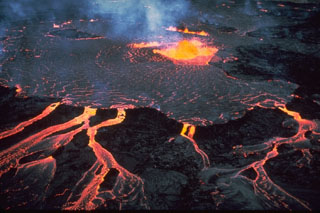Report on Kilauea (United States) — 21 May-27 May 2025
Smithsonian Institution / US Geological Survey
Weekly Volcanic Activity Report, 21 May-27 May 2025
Managing Editor: Sally Sennert.
Please cite this report as:
Global Volcanism Program, 2025. Report on Kilauea (United States) (Sennert, S, ed.). Weekly Volcanic Activity Report, 21 May-27 May 2025. Smithsonian Institution and US Geological Survey.
Kilauea
United States
19.421°N, 155.287°W; summit elev. 1222 m
All times are local (unless otherwise noted)
The Hawaiian Volcano Observatory (HVO) reported that the eruption within Kilauea’s Kaluapele summit caldera, characterized by episodic fountaining from two vents along the SW margin of Halema’uma’u Crater, continued at variable levels during 21-27 May. Incandescence at both the N and S vents was visible during 20-25 May, along with intermittent spattering at both vents and occasional dome fountaining at the N vent. Large yellow flames from burning hydrogen gas sometimes rose from the N vent. The sulfur dioxide emission rate averaged around 1,200 tonnes per day (t/d), similar to rates recorded during prior pauses between high fountaining events. After midday on 24 May minor fountaining at the N vent as high as 65 m was accompanied by lava overflowing the cone onto the crater floor. Strong incandescence and periodic vigorous spattering at both vents was visible in the afternoon of 24 May and overnight during 24-25 May. Lava fountaining at the N vent and an overspill of lava onto the crater floor also occurred overnight.
Narrow lava jets rose from the N vent on 25 May and became sustained fountains at 1615 which quickly began to cover the crater floor with lava flows. The activity escalated to fountains over 300 m tall within 30 minutes. Fountaining at the S vent began at 1720 and grew rapidly, reaching sustained heights of about 250 m. The fountains produced an eruptive plume heavily laden with tephra (ash, scoria, and Pele's hair) that reached at least 4.3 km in height. Sulfur dioxide emission rates were estimated to be 50,000-75,000 t/d based on webcam images from the Mauna Loa summit. Both vents produced lava flows that covered about half of the crater floor. After about six hours of sustained fountaining, the N vent stopped erupting at 2148, and the S vent stopped erupting at approximately 2225 on 25 May. Strands of Pele’s hair were present throughout the summit area of Hawai’i Volcanoes National Park and surrounding communities. The Volcano Alert Level remained at Watch (the third level on a four-level scale) and the Aviation Color Code remained at Orange (the third color on a four-color scale).
Geological Summary. Kilauea overlaps the E flank of the massive Mauna Loa shield volcano in the island of Hawaii. Eruptions are prominent in Polynesian legends; written documentation since 1820 records frequent summit and flank lava flow eruptions interspersed with periods of long-term lava lake activity at Halemaumau crater in the summit caldera until 1924. The 3 x 5 km caldera was formed in several stages about 1,500 years ago and during the 18th century; eruptions have also originated from the lengthy East and Southwest rift zones, which extend to the ocean in both directions. About 90% of the surface of the basaltic shield volcano is formed of lava flows less than about 1,100 years old; 70% of the surface is younger than 600 years. The long-term eruption from the East rift zone between 1983 and 2018 produced lava flows covering more than 100 km2, destroyed hundreds of houses, and added new coastline.
Source: US Geological Survey Hawaiian Volcano Observatory (HVO)

